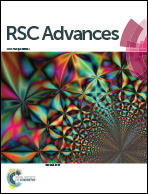Anthracene-based ferrocenylselenoethers: syntheses, crystal structures, Cu(i) complexes and sensing property†
Abstract
Three novel anthracene-based ferrocenylselenoethers, 1,5-diselena-3-(anthracen-9′-ylmethyl)-[5]ferrocenophane (L3), 1,3-bis(ferrocenylseleno)-2-(anthracen-9′-ylmethyl)propane (L4) and N,N-bis[2-(ferrocenylselena)ethyl]-N-(anthracen-9′-ylmethyl)amine (L5) and their Cu(I) complexes, [Cu2Br2(L2)2] (L2 = 1,1′-bis[2-(anthracen-9′-yloxy)-ethylseleno]ferrocene) (1), [Cu2I2(L2)2] (2), [Cu2I2(L3)2]·1.25CH2Cl2 (3) and [Cu4I4(L5)2]·CH2Cl2 (4), have been prepared and structurally characterized. The X-ray crystallography analysis reveals that the complexes 1–3 possess a rhomboidal Cu2X2 core which is sandwiched by two L ligands through two Se atoms to form a dimer, while 4 owns a distorted cubane-like Cu4I4 core which is double-bridging linked by two L5 ligands via two Se atoms to produce a 1D loop chain. Each Cu(I) ion in 1–4 displays a distorted tetrahedral geometry. The unique structural feature in L3–L5 is the coexistence of a redox moiety (ferrocenyl) and a fluorescent chromogenic group (anthracenyl). In the cation sensing study, L3 and L4 present multiresponsive signals for Cu2+ and Hg2+, L5 for Cu2+, Zn2+ and Hg2+. The selectivity can be tuned by incorporating an additional donor N atom, and/or oxidation of the ferrocene unit.


 Please wait while we load your content...
Please wait while we load your content...